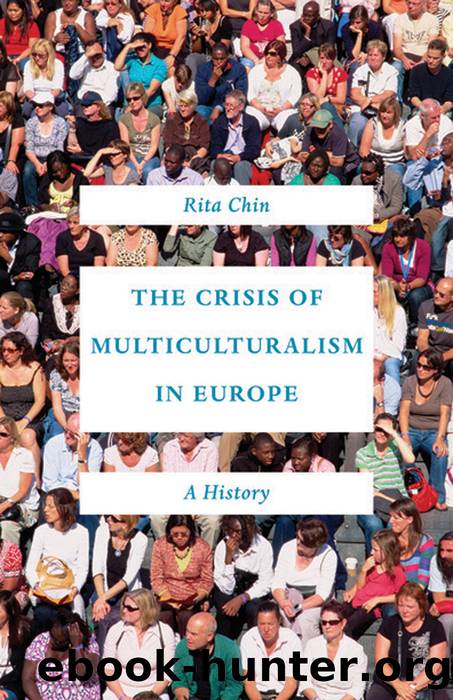The Crisis of Multiculturalism in Europe by Chin Rita;

Author:Chin, Rita;
Language: eng
Format: epub
Publisher: Princeton University Press
Published: 2017-07-14T16:00:00+00:00
CHAPTER FOUR
Muslim Women, Sexual Democracy, and the Defense of Freedom
On 18 September 1989 (roughly seven months after the Rushdie affair began), sisters Leila and Fatima Achaboun were sent home from the Collège Gabriel Havez, a public middle school in the town of Creil near Paris, for refusing to take off their headscarves (foulards) in the classroom. Three days later, a third student, Samira Saidani was also dismissed for covering her head. Although pupils had previously been permitted to wear headscarves, the school’s administrative council now declared that these coverings were no longer allowed. When the girls declined to comply with the new rule, school principal Ernest Chénière suspended them, on the grounds that headscarves infringed on “the laïcité and neutrality of the public school.”1 Several rounds of negotiation ensued, involving the school administration, parents, and a local Tunisian cultural association. The girls returned to school on 10 October after a compromise was reached: they would be permitted to wear headscarves on school grounds, but not in the classroom. Ten days later, however, the girls were dismissed a second time for violating the compromise. Soon, what had started as a local conflict escalated into a national controversy, with newspapers from around the country, government leaders, and public figures all weighing in. On the 25th of October, the National Assembly even convened a meeting—broadcast on national television—to determine how to address the questions raised by the Creil girls’ insistence on wearing headscarves in the classroom.2
Less clear is how these familiar events of 1989 fit within the broader history of postwar immigration. As I have already begun to suggest, this was the third time in less than five years that a major national debate had exploded over the relationship of immigrants to the demands of French citizenship. In this case, the controversy emerged not in a vacuum, but in the wake of Prime Minister Jacques Chirac’s efforts to revise the nationality code. This, in turn, soon led to the months-long public conversation about citizenship and its requirements conducted by the Nationality Commission in 1987. The headscarf affair in Creil echoed many of the broader issues from these earlier episodes, but it gave the public debates a much more specific object of scrutiny. Rather than considering abstract questions of how immigrant differences might mesh with newly resurgent ideas about French citizenship, public attention now centered on whether Muslim girls should be compelled to uncover their heads in public schools.
The Creil controversy also dovetailed with events in Britain in a number of important ways. Just as British officials interpreted Muslim calls to ban Rushdie’s novel as violating a key value enshrined in British culture, French authorities viewed the Muslim girls’ insistence on wearing the foulard as a challenge to the very terms of French citizenship. In both cases, local efforts to claim legitimacy for religious traditions were perceived as indications of cultural intractability, an unwillingness to compromise and assimilate in reasonable ways. The French affaire du foulard, in other words, seemed to confirm a growing
Download
This site does not store any files on its server. We only index and link to content provided by other sites. Please contact the content providers to delete copyright contents if any and email us, we'll remove relevant links or contents immediately.
| African-American Studies | Asian American Studies |
| Disabled | Ethnic Studies |
| Hispanic American Studies | LGBT |
| Minority Studies | Native American Studies |
Cecilia; Or, Memoirs of an Heiress — Volume 1 by Fanny Burney(31331)
Cecilia; Or, Memoirs of an Heiress — Volume 3 by Fanny Burney(30933)
Cecilia; Or, Memoirs of an Heiress — Volume 2 by Fanny Burney(30889)
The Great Music City by Andrea Baker(21262)
We're Going to Need More Wine by Gabrielle Union(18072)
Bombshells: Glamour Girls of a Lifetime by Sullivan Steve(13107)
Pimp by Iceberg Slim(12929)
All the Missing Girls by Megan Miranda(12746)
Fifty Shades Freed by E L James(12448)
Norse Mythology by Gaiman Neil(11880)
Talking to Strangers by Malcolm Gladwell(11874)
Crazy Rich Asians by Kevin Kwan(8347)
Mindhunter: Inside the FBI's Elite Serial Crime Unit by John E. Douglas & Mark Olshaker(7833)
The Lost Art of Listening by Michael P. Nichols(6469)
Enlightenment Now: The Case for Reason, Science, Humanism, and Progress by Steven Pinker(6405)
Bad Blood by John Carreyrou(5766)
The Four Agreements by Don Miguel Ruiz(5510)
Weapons of Math Destruction by Cathy O'Neil(5034)
We Need to Talk by Celeste Headlee(4868)
